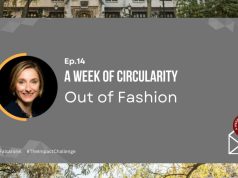INTERVIEW with Michiel De Smet, Finance Programme Lead with the Ellen MacArthur Foundation. For further expert opinions please use the question-level hyperlink.
| Ellen MacArthur Foundation recently released the report Financing the circular economy – Capturing the opportunity. Would you please elaborate on the key-findings?
Three weeks ago the Ellen MacArthur Foundation launched a position paper on financing the circular economy at its Summit, in conversation with BlackRock CEO Larry Fink, and with endorsement from more than 30 leading finance firms, including BlackRock, Intesa Sanpaolo, Barclays, Citi, Credit Suisse, HSBC, JP Morgan, Morgan Stanley, and UBS.
Key findings:
〉The circular economy can both help deliver on climate and other ESG goals, but also move beyond ESG as a source of new and better growth.
〉The market is taking off, with very rapid growth of circular economy financing over the last 18-24 months.
-
- No such fund existed in 2017, but by mid 2020 ten public equity funds focusing partially or entirely on the circular economy had been launched by leading providers, including BlackRock, Credit Suisse, and Goldman Sachs. Since the beginning of 2020, assets managed through these funds have increased six-fold, from USD 0.3 billion to over USD 2 billion. In the first half of 2020, on average these funds performed 5.0 percentage points better than their Morningstar category benchmarks.
-
- In the last 18 months, at least ten corporate bonds to finance circular economy activity have been issued by global companies such as Alphabet, BASF, PepsiCo, and Philips, with help from leading banks including Barclays, HSBC, ING, Morgan Stanley, and others.
-
- A similar trend is visible across the financial sector in private market funds, bank lending, project finance, and insurance. For example, Intesa Sanpaolo launched a EUR 5 billion credit facility, and the European Investment Bank partnered with five of Europe’s largest national promotional banks and institutions to launch a EUR 10 billion loan and investment initiative dedicated to the circular economy.
〉Now is the time for the financial services sector to build on this initial momentum and scale circular economy finance, which will require private and public sector action.
| According to the report, the total amount of assets managed through public equity funds with circular economy focus increased 6-fold since the beginning of 2020, from USD 0.3 billion to over USD 2 billion. What investment opportunities and risks should asset owners and managers keep an eye on?
Circular economy opportunities can be found in nearly every sector in the global economy. The plastics, fashion, and food sectors stand out as some of the most likely to be significantly impacted or even disrupted by the circular economy in the near term, driven by innovation, regulation, and evolving customer preferences. The paper Financing the circular economy – Capturing the opportunity provides a heatmap with an overview of the circular economy growth potential in ten key sectors, selected to demonstrate a broad range of circular economy opportunities. On the risk side, as the circular economy is an essential part of the solution to address climate change and ESG issues, it can help identify and manage associated risks. For example, in the plastic packaging industry, stricter regulation, stranded assets, and risk to brand and social license to operate, are risks linked to the current linear system. A circular approach can help anticipate and respond to these risks, for example, through eliminating problematic plastic packaging or increasing use of recycled content. At the same time, such an approach can go beyond risk mitigation by providing value creation opportunities through positive brand differentiation or innovative delivery models.
| How would you assess the current scale and potential scalability of circular economy?
〉The transition to the circular economy is happening.
-
- More and more companies are already innovating towards the circular economy to reduce costs, increase revenues, and manage risks. For example, Cisco operates a Takeback and Reuse Program which, through encouraging cycles of use, has created subscription revenue for the company in different markets. As these efforts are scaling up, the circular economy has started transforming entire industries. In fashion, for example, clothing resale is expected to be bigger than fast fashion by 2029.
-
- Governments are increasingly recognising the potential of the circular economy framework to increase competitiveness, develop more resilient supply chains, and deliver on societal and environmental objectives. In 2019, the European Commission presented the European Green Deal, of which the circular economy is a key pillar, and in early 2020 it published the Circular Economy Action Plan, which includes a detailed set of measures to be implemented over the next five years.
〉As an industrial transformation, the circular economy is about changing entire sectors, and ultimately the global economic system. As a result, circular economy opportunities can be found in nearly every sector in the global economy.
〉The circular economy financing market too is taking off. Yet while the recent growth in financing is promising, far more capital and activity will be needed to scale the circular economy and fully seize its opportunity.
| A paper published by the Ellen MacArthur Foundation last year stated that switching to renewable energy can only cut greenhouse gas emissions by 55%. How would you assess the role of circular economy in tackling climate change?
The circular economy is a crucial part of the solution to meet global climate targets by transforming the way we produce and use goods. Relying solely on energy efficiency and switching to renewable energy will only address 55% of global greenhouse gas emissions. By adopting circular practices, we can reduce a significant proportion of the remaining 45%. For example, circulating products and materials – instead of producing new ones – can help cut energy demand, by maintaining the embedded energy that went into making them. In agriculture, adopting circular principles through practices such as regenerative agriculture is an effective way to sequester carbon in the soil.
In 2019, the Foundation launched the report Completing the Picture – How the Circular Economy Tackles Climate Change, which shows how putting in place a circular economy is a fundamental step towards achieving climate targets.
| Already back in 2017 scientists warned of what they termed ‘circular economy rebound’, arguing that ‘circular economy activities can increase overall production, which can partially or fully offset their benefits’. Against the backdrop of the sustainable recovery discussion in EU, do you find that the respective risks are properly considered?
The circular economy transition is about changing the entire economy, which requires corporates, policymakers and the financial services sector to be involved. Such systems change is complex and won’t happen overnight. As the transition is happening, and new technologies and business models are being introduced, there might be rebound effects along the way. These can occur when people spend some of the money they save through circular solutions on products still in the linear economy, e.g. buying an unrecyclable disposable camera with the money saved by moving to a product-as-a-service arrangement for household appliances. The best way to mitigate the risks of such effects is to accelerate and broaden the shift to a circular economy so it covers all sectors and product groups. In a circular economy, since it is restorative and regenerative by design, the more we do, the better the results – for businesses, society, and the environment. In this context a ”rebound effect” would be welcome as it would support new forms of better growth.
| What actions do you find relevant to make the recovery as resilient as possible?
〉As we build back from the health and economic shocks of coronavirus we can do so in ways that make us stronger in the face of other challenges, such as climate change and loss of biodiversity.
〉The circular economy offers a pathway to redefined growth and enhanced resilience. It opens up opportunities to create value in ways that are decoupled from finite resources, regenerate natural systems, and help us tackle climate change. This boosts long-term economic growth by building financial and natural capital.
〉For example, designing for repair, reuse, and modularity have played a part in ensuring access to frontline medical equipment, and thriving regional food systems have helped to maintain food supplies in these challenging circumstances. Ideas like these are already helping to build thriving businesses and can help to shape the industries of the future.
〉The recent growth in circular economy financing is promising, but far more capital and activity will be needed to fully seize its opportunity. This will require the financial services sector to build on the initial momentum and scale the circular economy, which will require both private and public sector action.
〉Read about circular investment opportunities and key roles for policymakers in the Foundation’s Covid-19 insight papers.








